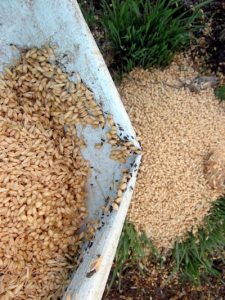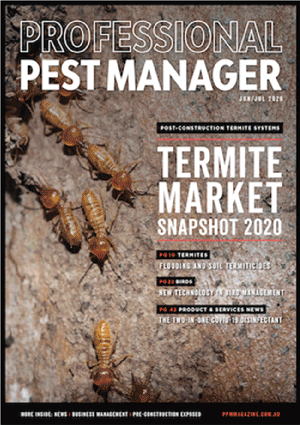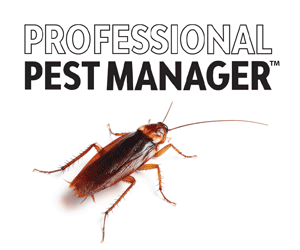John Field from Fumigation Training and Consulting Services outlines the process of using fumigants against stored product pests.
Fumigation is the process of controlling pests using gaseous pesticides.
You will notice that we refer to ‘control’ not ‘management’ when referring to fumigation outcomes – that means zero tolerance. If a fumigation technician does not achieve control the client will ultimately look to the fumigator to compensate for the client’s losses.
Fumigation of grain is the only readily available method to rectify insect infestations that most often occur during preparation, harvesting, in-loading and long-term storage. Fumigation is also the sole method of disinfesting obviously infested grain without actually moving it.

A fumigant is “A gaseous pesticide which is lethal to organisms (insects, animals, plants, fungi) if they are exposed to a sufficient gas concentration, for a sufficient length of time”. If one or more of these elements are missing, or are insufficient, then the fumigation will most likely fail. For some fumigants, this could result in resistant insect strains being developed, while other failed fumigations will simply result in the target insect surviving the treatment. In some cases you cannot re-fumigate using the same product/ fumigant as you will destroy the commodity being treated.
The differences between methods of grain fumigation are related primarily to the type of fumigant initially applied to the grain mass. The most common fumigation enclosures used for treatment of stored grain in Australia include; silos, containers, sheeted stacks (pallets of bagged commodity under fumigation sheets), bunkers (really large volumes of bulk grain under fumigation sheets), sealed sheds and ship holds. The most common fumigants currently being used include – phosphine in various forms and preparations including Eco2Fume, Methyl bromide (totally restricted to quarantine pre-shipment), and in the last few years, Vapormate and Profume (sulfuryl fluoride) have been approved.

Most fumigants must be applied by a licensed fumigation technician. There must also be a second person onsite, also equipped with the appropriate PPE (full face gas respirator with a gas canister specific to the fumigant being used, or an SCBA unit), while the fumigation technician is actually within the ‘risk area’ (3m if an outside enclosure and 6m if the enclosure is within a building). Some gasses specify a SCBA unit be worn due to the nature of the gas. No licensed fumigation technician can be legally within a risk area without another responsible person being present and if unlicensed no person can be within the designated risk area unless in the presence of a licensed technician.
Unfortunately a few forms of phosphine tablets are still legally available to untrained and unlicensed growers. This is one of the main causes of the development and spread of resistant strains of grain insects since untrained applicators generally do not understand the processes involved, or have the equipment required to undertake and monitor a successful fumigation. Some fumigators also fall into this category, but thankfully their numbers are lessening as a result of licensing requirements, government agency audits, and clients (both onshore and offshore) demanding successful treatments.
Licensing requirements unfortunately vary between each state but the common baseline requirement is National Competency Unit CPPPMT3011A Conduct fumigation, plus any additional state and territory requirements.
The current licensing requirements are:
- QLD – CPPPMT3011A Conduct fumigation plus Site Declaration – silo, container, stack etc
- NSW – CPPPMT3011A Conduct fumigation plus CPPPMT3006A Apply pesticides to manage pests
- VIC – CPPPMT3011A Conduct fumigation plus Gas Specific
- TAS – CPPPMT3011A Conduct fumigation plus Gas Specific
- SA – CPPPMT3011A Conduct fumigation plus CPPPMT3006A Apply pesticides to manage pests, plus CPPPMT3018B Maintain an equipment and chemical storage area plus Gas Specific
- WA – CPPPMT3011A Conduct fumigation plus CPPPMT3019A Organise and monitor pest management operations, CPPPMT3043A Prepare and present a pest management submission including quotation, BSBSBM407A Manage a small team
- NT – CPPPMT3011A Conduct fumigation plus First Aid Certificate plus Doctors Certificate plus Site & Gas Specific plus three fumigations under supervision for each type of site and gas.
Gas-tight structures that retain a sufficient concentration of fumigant for the required period of time are essential for effective fumigations. For the fumigant phosphine, gas tightness is particularly important. Phosphine needs to be retained within the enclosure for the complete life cycle development period of the target insect pest, which may vary from 7-21 days depending upon temperature. In comparison, Methyl bromide and Profume are 24-hour fumigants when maintained at operational concentrations. High dosage rates do not compensate for inadequate standards of gas tightness or poor fumigation practices and are not permitted.
The client must also realise that the fumigation period, stated above, does not include the time required to bring the gas up to the correct concentration within the enclosure. Sometimes this may take several days depending upon the fumigant and commodity configuration prior to the retention time commencing, plus the period required at the completion of the retention time to ventilate the fumigant from within the enclosure in order for it to be handled safely. This may take from less than an hour to several days. These considerations can take a 24-hour fumigation out to a 48- hour fumigation and a seven-day fumigation out to 10 days or longer, depending upon commodity type and volume, the fumigant used and the type of circulation and ventilation equipment employed.
John Field, Fumigation Training and Consulting Services
John Field has been a licensed pest management trainer for 29 years and a qualified fumigation technician for 27 years. John operated a successful pest management and fumigation business prior to moving into management roles with several leading industry organisations. John realised an opportunity to move into training in April 2004 and now operates two international training and consulting organisations – PEST Consultants specialises in pest management and FTCS specialises in fumigation. John can be contacted via www.pestc.com.au or www.ftcs.net.au 07 5547-0041 or 0409 484-404.



